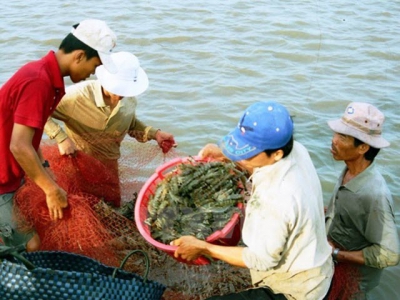Kien Giang applies advanced technologies in large-scale shrimp farming

The Mekong Delta province of Kien Giang will promote the application of advanced technologies in shrimp farming on large scale until 2025. (Photo: VNA)
Kien Giang (VNA) – The Mekong Delta province of Kien Giang will promote the application of advanced technologies in shrimp farming on large scale under its master plan on shrimp development until 2025.
Accordingly, the province will shift 5,000 hectares of extensive culture of shrimp to industrial and semi-industrial shrimp farming by 2020, of which 4,700 hectares are in the Long Xuyen Quadruple and 300 hectares in U Minh Thuong.
Automatic water environment monitoring stations will be set up serving both aquaculture and environmental protection in this period.
The total area of brackish water shrimp farming is projected at 127,850 ha in 2020.
Meanwhile, the 2021-2025 period will see the formation of a high-tech shrimp industry along with the development of shrimp-rice farming model and large-scale extensive shrimp cultivation. Total shrimp farming area will be expanded to 129,450 ha.
Advanced technologies will continue to be applied on a large scale to reduce chemicals and antibiotics during the entire shrimp production. Besides, the shrimp industry will be developed into a complete value chain, helping increase added value of the local staple.
More than 20,000 hectares of rice cultivation in areas hit by saline intrusion during dry season in U Minh Thuong and Tu Giac Long Xuyen will be switched to shrimp-rice farming.
The province will invest heavily in technical infrastructure to improve breeding production.
Kien Giang earned 213 million USD from the export of aquatic products in 2018.
Có thể bạn quan tâm
 Local shrimp farmers to operate on trading floor
Local shrimp farmers to operate on trading floor Local shrimp farmers in the Mekong Delta region and across the country will be able to sell their shrimp products on a trading floor in the coming period.
 Warning that exported seafood has 'cooled down' but it still has a high level
Warning that exported seafood has 'cooled down' but it still has a high level In 2018, although not reaching the amazing figures from 2017, the number of seafood export consignments remain high.
 Tiền Giang to develop clam farming in coastal area
Tiền Giang to develop clam farming in coastal area Clams are weighing up stably with only 30ha of clams being found dead (20-30%), down by 50% as compared to the previous year